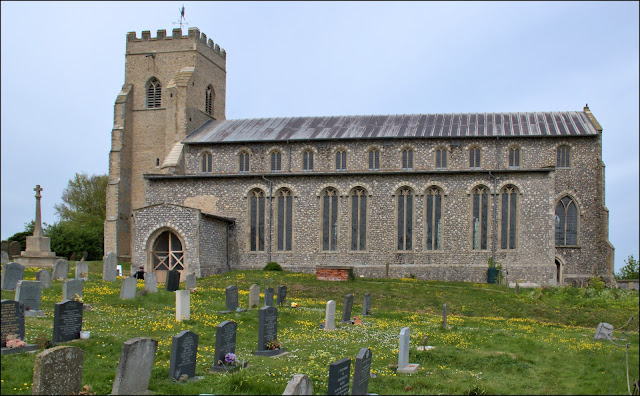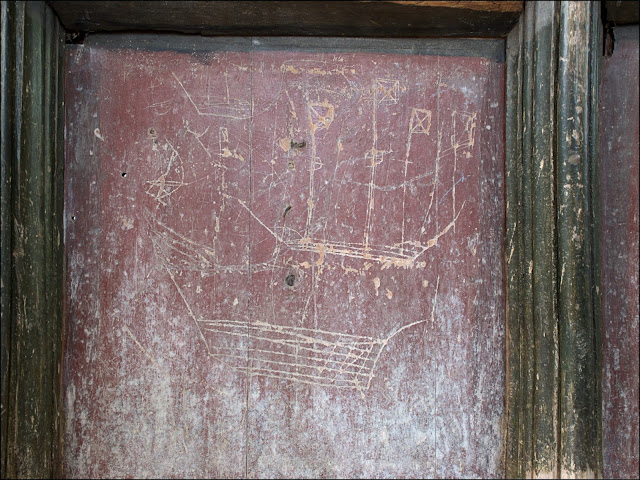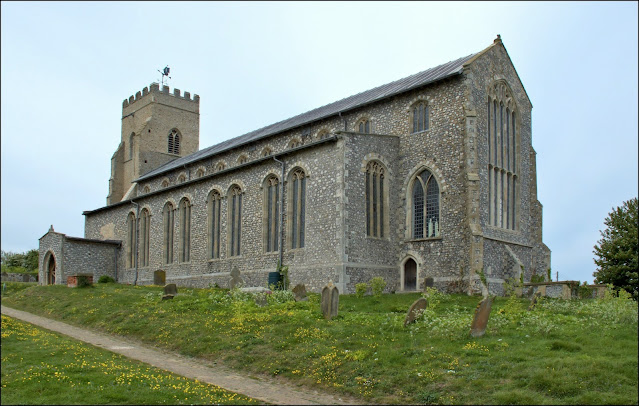We were on our way to Salthouse on the North Norfolk coast and this time I hoped to visit the church which I failed to see last time we were up this way. As we travelled the roads through Cambridgeshire, parts of Suffolk and across Norfolk, we passed mostly arable fields, but very few sheep. That wouldn't have happened a few centuries ago. (The old boy's rambling again, but he usually gets to the point in the end).
What we did arrive at was the little village of Salthouse and it's impressive church. I think you can see immediately that the whole of the body of the church is all built in one style, apart from the tower, which looks a bit older. It's not normal to find village churches like this; most of them have had many additions and alterations over time.
The church was totally rebuilt during the fifteenth century, paid for by Sir Henry Heydon. Sir Henry sank part of his considerable fortune into several building projects and this church was just one of them. Although he was knighted he spent most of his time, not at court, but in Norfolk, and later down in Kent where he built himself another mansion. And, believe it or not, he amassed all his wealth from farming sheep. He also married Anne Boleyn (not Henry VIII's unfortunate wife, but one of her ancestors).
A little of the church's former glory can be glimpsed on these painted panels, though the passing years have not been kind to them. They are said to represent saints and prophets. More interesting to me was what was on the reverse of the panels...
... crudely scratched pictures of ships. For years such writings and drawings were called "church graffiti" and thought to be the work of naughty boys. But some are in Latin which suggests that they were written by learned men, perhaps clergymen. This has prompted the idea that they were a symbolic act, rather like lighting a candle in church nowadays. Some of these inscriptions appear to be praying for a safe return from a voyage. And maybe those who couldn't write drew pictures of ships for the same reason. Whether that's all true or not, some of the ships drawn in Blakeney church, just down the road, are so detailed that they can only have been drawn by sailors.
Here at Salthouse there's a magnificent font to marvel at too. It bears a carving of the Tudor rose which suggests it must be much the same age as the church itself, but most people enjoy looking at the rather comical lions.
Whatever was intended to be conveyed by the inclusion of these wild beasts on the font, I think we may assume that the sculptor had never seen a lion, but instead its appearance had been conveyed to him by a series of "Chinese whispers". I like its silly smile!
LATE PREACHER OF GODS WORD AT HAPPISBVRGH
WHO DYED YE 4 DAY OF IANVARI ANO DNI 1638 AGED 63
No, I've no idea why the Vicar of Happisburgh was buried, some twenty miles from his own church, in Salthouse.
The reason why we have this unblemished example of a fifteenth church left in such original condition is sheer neglect. Soon after it was built the money ran out, perhaps because the port silted up or else because the descendants of Sir Henry chose to spend their fortune elsewhere. If cash had continued to be available then surely the tower would have been replaced too.
What we see today is exactly what was seen as pious good taste in the fifteenth century - an impressively large building but with simple, graceful lines and free from fussy ornamentation.
The population of the small town has dwindled over the centuries to just two hundred. It's a surprise that the building has survived as well as it has - these flint-built churches have collapsed in many other places and this one sits in an exposed position right on the coast.
We'll have a look at the coast and countryside around Salthouse in the next post.
Take care.














Really interesting tour of the church particularly the 'graffiti' explanations.
ReplyDeleteTwo of my very favourite villages and churches - we have twice spent a week's holiday in the Blakeney Hotel - one of my favourite (apart from the parking which is not always easy Those old Suffolk churches were I think mostly built on wool. Thanks for a lovely reminder.
ReplyDeleteThank you for this beautifully illustrated history lesson. Love the graffiti, the wind vane - and of course the lions. That is one elegant church - particularly from the inside....
ReplyDeleteI must ask (perhaps a dumb question for those who know about it) what is the purpose of the cart inside the church? It looks like a luggage cart to me. I'll click "Notify Me," so you can answer if you wish right here as a reply to my comment. Or comment over on my blog...your choice, but I do hope you know the answer!
ReplyDeleteSorry, I meant to mention that. It's an old bier trolley, used to transport the corpse and coffin from the deceased's home to church before a funeral. These old wooden biers are very rarely used these days, though modern aluminium trolleys are still part of the undertaker's equipment. A jolly subject!
DeleteThanks for prompt reply. I appreciate it, and now I know too!
DeleteI've been to the town a few times but never went in the church so thanks for the tour. We went there to eat and wander the coast.
ReplyDeleteI like the muted colours of the inside of the church. The lions do look jolly.
ReplyDeleteThis was a wonderful tour of this old church, John. I also appreciated Barbara's question about the large cart and learning the explanation of its use and you're right, not a jolly subject at all.
ReplyDeleteWhat a beautiful old church to visit which does have some interesting features to see, the old doorway near the end in particular.
ReplyDeleteThe old church is still looking good.these days. Thanks for the tour, John.
ReplyDeleteSomeone is still spending money on that church. It is quite magnificent. Thanks for the history lesson too.
ReplyDeleteThere is something starkly beautiful about the inside of that church!
ReplyDeleteLovely old church and its fascinating history to accompany the photos.
ReplyDeleteYou have a deft touch, John, when you lead us on one of these tours, with a full explanation of all that we see. History comes alive on your blog!
ReplyDeleteWhat a beauty. I know I always make this comment, and if I don't make it, I think about the skill and the labor it took to built this that long ago! And here it still stands. I loved seeing your views of it.
ReplyDeleteWhat a beautiful and interesting church, both from inside and outside. The lions look very cute. In fact, they look like lambs, very Biblical. :)
ReplyDeleteThank you for your comment. It's always a joy to hear from you!
You too, take care.
Hi John - Norfolk is such an interesting county, as too the other counties ... amazing churches too .. I always enjoy reading your posts and then the excellent pics - thank you - cheers Hilary
ReplyDeleteA very appealing church.
ReplyDelete